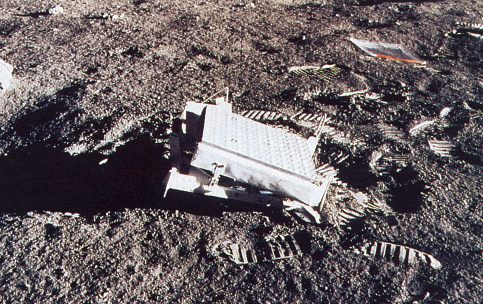Measuring the Moon's Distance
Apollo Laser Ranging Experiments Yield Results
From LPI Bulletin, No. 72, August, 1994
Scientists who analyze data from the Lunar Laser Ranging Experiment have reported some watershed results from these long-term experiments, begun 25 years ago when the Apollo 11 astronauts deployed a reflector array in the Sea of Tranquillity. "Using the Lunar Laser Ranging Experiment, we have been able to improve, by orders of magnitude, measurements of the Moon's rotation," said Jet Propulsion Laboratory team investigator Dr. Jean Dickey. "We also have strong evidence that the Moon has a liquid core, and laser ranging has allowed us to determine with great accuracy the rate at which the Moon is gradually receding from the Earth."
 The first laser ranging retroreflector
was positioned on the Moon in 1969 by the Apollo 11 astronauts. By beaming
laser pulses at the reflector from Earth, scientists have been able to determine
the round-trip travel time that gives the distance between the two bodies
at any time to an accuracy of about 3 centimeters. The laser reflector consists
of 100 fused silica half-cubes, called corner cubes, mounted in a 46-centimeter
square aluminum panel. Each corner cube is 3.8 centimeters in diameter. Corner
cubes reflect a beam of light directly back toward the point of origin.
The first laser ranging retroreflector
was positioned on the Moon in 1969 by the Apollo 11 astronauts. By beaming
laser pulses at the reflector from Earth, scientists have been able to determine
the round-trip travel time that gives the distance between the two bodies
at any time to an accuracy of about 3 centimeters. The laser reflector consists
of 100 fused silica half-cubes, called corner cubes, mounted in a 46-centimeter
square aluminum panel. Each corner cube is 3.8 centimeters in diameter. Corner
cubes reflect a beam of light directly back toward the point of origin.
"Lunar ranging involves sending a laser beam through an optical telescope," Dickey said. "The beam enters the telescope where the eye piece would be, and the transmitted beam is expanded to become the diameter of the main mirror, then bounced off the surface toward the reflector on the Moon."
The reflectors are too small to be seen from Earth, so even when the beam is precisely aligned in the telescope, actually hitting a lunar retroreflector array is technically challenging. At the Moon's surface the beam is roughly four miles wide. Scientists liken the task of aiming the beam to using a rifle to hit a moving dime two miles away.
Once the laser beam hits a reflector, scientists at the ranging observatories use extremely sensitive filtering and amplification equipment to detect the return signal, which is far too weak to be seen with the human eye. Even under good atmospheric viewing conditions, only one photon is received every few seconds.
From the ranging experiments, scientists know that the average distance between the centers of the Earth and the Moon is 385,000 kilometers with an accuracy of better than one part in 10 billion. Laser ranging has also made possible a wealth of new information about the dynamics and structure of the Moon. Among many new observations, scientists now believe that the Moon may harbor a liquid core. The theory has been proposed from data on the Moon's rate of rotation and very slight bobbing motions caused by gravitational forces from the Sun and Earth.
Ranging has also determined that the length of an Earth day has distinct small-scale variations of about one thousandth of a second over the course of a year, caused by the atmosphere, tides, and Earth's core. In addition, precise positions of the laser ranging observatories on Earth are slowly drifting as the crustal plates on Earth drift. The observatory on Maui is seen to be drifting away from the observatory in Texas.
Data also indicate that ocean tides on Earth have a direct influence on the Moon's orbit. Measurements show that the Moon is receding from Earth at a rate of about 3.8 centimeters per year. Ranging has also improved historic knowledge of the Moon's orbit, enough to permit accurate analyses of solar eclipses as far back as 1400 BC. Continued improvements in range determinations and the need for monitoring the details of the Earth's rotation will keep the lunar reflector experiments in service for years to come.